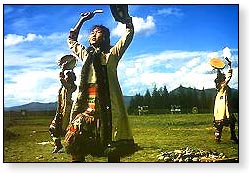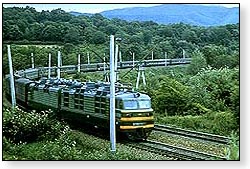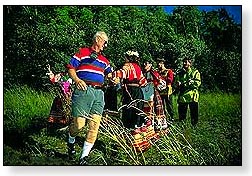 Russia's
Russia's
Trans-Siberian Railway
 For those who travel for the pleasure of the journey, those who
believe that getting there is as much fun as being there, Russia's Trans-Siberian Railway
has long been an almost mythic experience. It is the longest continuous rail line on
earth, each run clattering along in an epic journey of almost six thousand miles (or about
ten thousand kilometers) over one third of the globe. For most of its history, the
Trans-Siberian journey has been an experience of almost continuous movement, seven days or
more of unabated train travel through the vast expanse of Russia. A great part of the
pleasure of such a trip is simply sitting back and watching the land go by. However, most
travelers on the Trans-Siberian find that interaction with other passengers, both Russians
and tourists, is what makes the trip an unforgettable experience. Today, with far fewer
travel restrictions, it is possible to use the rail journey as the core of a more varied
tour. Travelers can enjoy stopovers in many of the Russian cities
and towns along the route, from the historic Volga port of Yaroslavl to Irkutsk and
the scenic Lake Baikal region.
For those who travel for the pleasure of the journey, those who
believe that getting there is as much fun as being there, Russia's Trans-Siberian Railway
has long been an almost mythic experience. It is the longest continuous rail line on
earth, each run clattering along in an epic journey of almost six thousand miles (or about
ten thousand kilometers) over one third of the globe. For most of its history, the
Trans-Siberian journey has been an experience of almost continuous movement, seven days or
more of unabated train travel through the vast expanse of Russia. A great part of the
pleasure of such a trip is simply sitting back and watching the land go by. However, most
travelers on the Trans-Siberian find that interaction with other passengers, both Russians
and tourists, is what makes the trip an unforgettable experience. Today, with far fewer
travel restrictions, it is possible to use the rail journey as the core of a more varied
tour. Travelers can enjoy stopovers in many of the Russian cities
and towns along the route, from the historic Volga port of Yaroslavl to Irkutsk and
the scenic Lake Baikal region.
Routes and Western Extensions
 Travel along the Trans-Siberian Railway is
usually undertaken from west to east, though it is quite possible to go in the opposite
direction. Moreover, a number of choices of route are available, as are extensions of the
journey on either end.
Travel along the Trans-Siberian Railway is
usually undertaken from west to east, though it is quite possible to go in the opposite
direction. Moreover, a number of choices of route are available, as are extensions of the
journey on either end.
The usual route taken by travellers is the Trans-Siberian line, which runs from Moscow to Vladivostok, passing through Yaroslavl on the Volga, Exaterinburg in the Urals, Irkutsk near Lake Baikal's southern extremity, and then Khabarovsk. From Vladivostok it is possible to continue by ferry to Niigata on the west coast of Japan.
A second primary route is the Trans-Manchurian line, which coincides with the Trans-Siberian as far as Tarskaya, a few hundred miles east of Baikal. From Tarskaya the Trans-Manchurian heads southeast into China and makes its way down to Beijing.
The third primary route is the Trans-Mongolian line, which coincides with the Trans-Siberian as far as the Buddhist enclave of Ulan Ude on Baikal's eastern shore. From Ulan-Ude the Trans- Mongolian heads south to Ulaan-Baatar before making its way southeast to Beijing.
In 1984, a fourth route running further to the north was finally completed, after more than five decades of sporadic work. Known as the Baikal Amur Mainline, this recent extension departs from the Trans-Siberian line several hundred miles west of Lake Baikal and passes the lake at its northernmost extremity. It reaches the Pacific to the northeast of Khabarovsk, at Imperatorskaya Gavan. While this route provides access to Baikal's stunning northern coast, it also passes through some pretty forbidding terrain.
To the west, connections are available through Moscow to Berlin (and from there to Paris), to Budapest, and to St. Petersburg (and from there to Helsinki).
History of the Railway
Russia's longstanding desire for a Pacific port was realized with the foundation of Vladivostok in 1860. By 1880, Vladivostok had grown into a major port city, and the lack of adequate transportation links between European Russia and its Far Eastern provinces soon became an obvious problem. In 1891, Czar Alexander III drew up plans for the Trans-Siberian Railway and initiated its construction. Upon his death three years later, the work was continued by his son Nicholas. Despite the enormity of the project, a continuous route was completed in 1905, having been rushed to completion by the outbreak of the Russo-Japanese War the year before. The present route of the line, including both the difficult stretch around Baikal and a northerly replacement for the dangerously situated Manchurian line, was opened in 1916.
Cities and Towns Along the Way
 The Trans-Siberian trains
stop several times a day, for periods ranging from just a few moments to almost half an
hour. Even the longest stops, however, allow for little more than a quick expedition from
the station to make some necessary purchases. It is possible, however, to arrange a
stopover in many of the major destinations along the route, and what follows is a brief
listing of some of the most popular sites.
The Trans-Siberian trains
stop several times a day, for periods ranging from just a few moments to almost half an
hour. Even the longest stops, however, allow for little more than a quick expedition from
the station to make some necessary purchases. It is possible, however, to arrange a
stopover in many of the major destinations along the route, and what follows is a brief
listing of some of the most popular sites.
Yaroslavl
One of Russia's oldest cities, Yaroslavl was founded by
Yaroslav the Wise of Kievan Rus' in 1010. Over the next several centuries the city
prospered as a trading port on the Volga and a center of textile manufacture, becoming by
the 17th century the second largest city in Russia behind Moscow. Its wealthy merchant
community became notable patrons of the arts, building hundreds of churches. Fortunately,
the great majority of these remain intact today, making the city one of the most beautiful
destinations along the railway.
Ekaterinburg
The Trans-Siberian's first major stop in Asian Russia is the
major industrial city and transport hub of Ekaterinburg. The town was founded in 1721 by
Catherine the Great as a fort and metallurgical factory, its position having been chosen
for its strategic proximity to the great mining operations of the Urals and Siberia.
Although there are few tourist sites here other than the 18th-century cathedral, the city
is nonetheless of great historical interest. It was here, in a house that once stood on
Liebknecht ulitsa, that Tsar Nicholas II and his family were executed on the morning of
July 17, 1918. Although the house no longer exists, its site is marked by a plain wooden
cross. The Imperial family, like most tourists, was brought to Ekaterinburg on the Trans-
Siberian. Ekaterinburg is also notable for being the hometown of Boris Yeltsin.
Krasnoyarsk
One of the older towns in Siberia, Krasnoyarsk was founded in
1628 as a trading post along the Yenisei River. It grew rapidly when gold was discovered
in the region, and eventually became a major river port and industrial center. Outside the
ciy is the Stolby Reserve, an attractive preserve notable for the odd, columnar cliffs
that rise from the river's edge inside its area. After one passes over the Yenesei,
another of the Trans-Siberian's most significant border crossings takes place--one leaves
the steppe and plunges into the taiga, the great forest that extends over most of Russia.
The vast Siberian taiga is the largest remaining forest in the world.
Irkutsk
Irkutsk became a wealthy trading center soon after its
founding in the 1660s, benefiting from its position along overland trade routes between
China and Western Russia. Since then it has maintained its position as the regions most
important city, though today its attraction for visitors is supplemented by its proximity
to Lake Baikal. Trans Siberian Railway enthusiasts should try to make it for a visit in
1998, when the city has planned a celebration commemorating the inauguration of the rail
line.
Ulan Ude
Like most Siberian cities, Ulan Ude was founded during the
17th century. However, as the center of the Buddhist Buryat culture, it is unlike any of
the other stops along the Trans-Siberian railway. Although the city's Buddhist tradition,
like all other religions, suffered a sharp decline under Stalin, there has been a
noticeable revival in recent years. Visitors to Ulan Ude today should not miss the
opportunity to visit nearby Ivolginsk Datsan, a restored Tibetan Buddhist monastery which
now serves as the center of Buddhism in Russia.
Khabarovsk
Strategically located on the hills overlooking the Amur River,
Khabarovsk was founded as a military outpost in 1651, during the first wave of Russian
colonization. The town gained importance during the nineteenth century as a trading
outpost, and today it is one of the most important and promising cities of the Russian Far
East. Khabarovsk is a pleasant city, with wide, tree-lined boulevards, a popular beach,
and an interesting museum of ethnography and local history.
Vladivostok
Vladivostok was founded in 1860 as a military outpost, but its
outstanding natural harbour soon brought it prosperity as a trading port. The city's
nomination as the headquarters of the Russian Pacific fleet in the 1870s brought further
growth, and by the twentieth century it had become a major center of international trade.
During the Soviet era, Vladivostok's military role eclipsed its trading function, and the
city was closed both to foreigners and to Soviet citizens lacking special entry
permission. The city was opened once again to visitors in 1992. It is currently
experiencing a rapid recovery of its historic role as a major Pacific commercial port and
has also maintained its naval importance as the headquarters of the Russian Pacific Fleet.
Today Vladivostok is a a lively, attractive city, with a wealth of attractions and, as
always, a strikingly impressive harbour.
Copyright (c) 1996-2006 interKnowledge Corp. All rights reserved.







